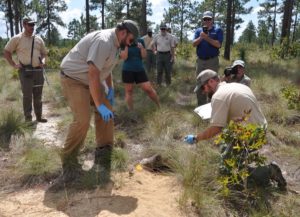Young gopher tortoises get head start before being released at Heritage Preserve
Dede Biles
Aiken Standard
September 29, 2017

WINDSOR — As wildlife releases go, it wasn’t a dramatic event.
There weren’t any flapping wings or flippers churning through the crashing surf
Instead, after being placed in front of a burrow made and used by others of their species, two young gopher tortoises immediately crawled through its dark entrance Tuesday afternoon.
And that, pretty much, was it.
But setting free the slow-moving reptiles was an important step in an ongoing effort to increase the population of the creatures at the Aiken Gopher Tortoise Heritage Preserve.
“This has been a work in progress for a long time,” said Will Dillman, a herpetologist with the S.C. Department of Natural Resources, or DNR.
Also involved in the effort, along with Dillman’s agency, are the University of Georgia’s Savannah River Ecology Laboratory (SREL), The Longleaf Alliance, National Fish and Wildlife Foundation, U.S Fish and Wildlife Service and Riverbanks Zoo & Garden.
“It’s been an interesting project, and it’s taken a lot of collaboration,” Dillman said.
In the Palmetto State, gopher tortoises are considered endangered animals. Aiken County is at the very edge of their northern range.
They also live in Louisiana, Mississippi, Alabama, Georgia and Florida.
To give baby gopher tortoises a head start in life locally, eggs laid by the reptiles are removed from the preserve and hatched at SREL. The resulting babies then are raised for a while at SREL and Riverbanks, where they get plenty of food to eat and are safe from predators.
In all, 10 young gopher tortoises were divided into pairs and set free in various locations at the Heritage Preserve on Tuesday.
The group included three 2-year-olds and two 1-year-olds. There also were five hatchlings.
“Little radio transmitters are attached to them so we can track them and see how well they survive and how far they move,” said Dr. Kurt Buhlmann, a senior research associate at SREL.
Later in the week, more young gopher tortoises from the three different age groups were scheduled to be let go in the Heritage Preserve.
“Another way we are trying to build this population is by using what we call orphan tortoises,” Buhlmann said. “They come from other places and can’t be returned to the exact population that they came from. With these big, old adult animals, we are trying to figure out the best way to establish them here on the landscape. We put them in pens for up to a year so they start to feel like this is their home.”
Another aspect of the gopher tortoise project at the Heritage Preserve involves restoring, maintaining and preserving the habitat that gopher tortoises love.
The longleaf pine savannah has scattered trees along with lots of grass and other herbaceous plants that the animals eat.
One of the management techniques used is a controlled or prescribed burn, which helps keep the open areas between the pines from disappearing.
“It is a lot of work to fix the landscape and make it a grassland, which is what the tortoises like,” Buhlmann said.
Dede Biles is a general assignment reporter for the Aiken Standard and has been with the newspaper since January 2013. A native of Concord, N.C, she graduated from the University of North Carolina at Chapel Hill.
